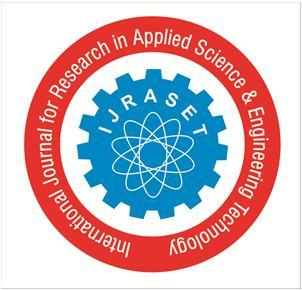
3 minute read
International Journal for Research in Applied Science & Engineering Technology (IJRASET)
from Exploring Smart- Quill Technology Chirography Remembrance in addition to Impression Corroboration
by IJRASET

ISSN: 2321-9653; IC Value: 45.98; SJ Impact Factor: 7.538
Advertisement
Volume 11 Issue IV Apr 2023- Available at www.ijraset.com
The Node MCU ESP8266 Wi-Fi module is a SOC microchip that is mostly used for developing end-point IoT (Internet of things) applications. It is referred to as a standalone wireless transceiver, and it is relatively inexpensive. It is used to link numerous embedded system applications to the internet.
Pin Configuration: The ESP8266-01 Wi-Fi module has two modes of operation. They are as follows:
When the GPIO-0 and GPIO-1 pins are active high, the module executes the software that was uploaded to it.
UART Mode: When GPIO-0 is active low and GPIO-1 is active high, the module enters programming mode and may becontrolled through serial connection via an Arduino board.
VI. CONCLUSION
There were preceding IOT-based projects for Heart Rate Variability (HRV) and some Machine Learning (ML)-based projects for HRV. However, we use and utilize the Internet OfThings (IoT) and ML for HRV to forecast the risk of cardiac patients in real time. Using machine learning and HRV potentialities, the project can estimate health status and anticipate patients' heart health (low-risk or high-risk) based on the ECG waveform and HRV characteristics such as time domain and frequency domain values. In Machine Learning, we employed the Convolutional Neural Network approach to identify the stages of Hearth Risk.
VII. ACKNOWLEDGEMENT
We are thankful to our guide of IT department, Prof. Manasi Deore for helping, giving guidance & giving information in “Real-time risk prediction of heart patients using HRV and IoT ”.
References
[1] P. Kumar, A. K. Das and S. Halder, "Interpretation of Premature Ventricular Abnormality based on HRV Analysis," 2021 5th International Conference on Electronics, Materials Engineering & Nano-Technology (IEMENTech), 2021, pp. 1-4, doi:10.1109/IEMENTech53263.2021.9614725.
[2] M. Bahameish and T. Stockman, "Fundamental Considerations of HRV Analysis in the Development of Real-Time Biofeedback Systems," 2020 Computing in Cardiology, 2020, pp. 1-4, doi: 10.22489/CinC.2020.078.
[3] A. C. Podaru and V. David, "A Simple Method for Determining the HRV Parameters," 2020 International Conference and Exposition on Electrical And Power Engineering (EPE), 2020, pp. 151-155, doi: 10.1109/EPE50722.2020.9305660.
[4] E. Alharbi and A. Alomainy, "Machine Learning approach to Predict Cognitive Performance using HRV," 2022 2nd International Conference on Computing and Information Technology (ICCIT), 2022, pp. 379-382, doi: 10.1109/ICCIT52419.2022.9711625.
[5] S. Bhowmick, P. K. Kundu and D. Das Mandal, "HRV Performance Analysis in Photoplethysmography and Electrocardiography," 2020 IEEE Calcutta Conference (CALCON), 2020, pp. 342-345, doi: 10.1109/CALCON49167.2020.9106418.
[6] M. Umair, N. Chalabianloo, C. Sas and C. Ersoy, "HRV and Stress: A Mixed-Methods Approach for Comparison of Wearable Heart Rate Sensors for Biofeedback," in IEEE Access, vol. 9, pp. 14005-14024, 2021, doi: 10.1109/ACCESS.2021.3052131.
[7] M. Aqib, A. Alam and A. Q. Ansari, "IoT based ECG System for Arrhythmia Detection using Telemetry Monitoring," 2022 9th International Conference on Computing for Sustainable Global Development (INDIACom), 2022, pp. 437-442, doi: 10.23919/INDIACom54597.2022.9763246.
[8] M. S. Yadav, M. M. Basha, B. A. Kumar and V. A. Goud, "IoT Based Secluded HRV System for Monitoring Hypertensive Patients," 2021 International Conference on Recent Trends on Electronics, Information, Communication & Technology (RTEICT), 2021, pp. 880-883, doi: 10.1109/RTEICT52294.2021.9573768.
[9] M. M. Edris and H. Altural, "IoT-Based Monitoring System for Detection of Epileptic Seizure by Heart Rate Variation," 2021 Medical Technologies Congress (TIPTEKNO), 2021, pp. 1-3, doi: 10.1109/TIPTEKNO53239.2021.9632956.
[10] S. P. Preejith, R. Dhinesh, J. Joseph and M. Sivaprakasam, "Wearable ECG platform for continuous cardiac monitoring," 2016 38th Annual International Conference of the IEEE Engineering in Medicine and Biology Society (EMBC), 2016, pp. 623-626, doi: 10.1109/EMBC.2016.7590779.
[11] J. Muhlsteff et al., "Wearable approach for continuous ECG - and activity patient-monitoring," The 26th Annual International Conference of the IEEE Engineering in Medicine and Biology Society, 2004, pp. 2184- 2187, doi: 10.1109/IEMBS.2004.1403638.
[12] Meiran Peng, Tiandong Wang, Guangshu Hu and Hui Zhang, "A wearable heart rate belt for ambulant ECG monitoring," 2012 IEEE 14th International Conference on e-Health Networking, Applications and Services (Healthcom), 2012, pp. 371-374, doi: 10.1109/HealthCom.2012.6379440.
[13] U. Shirole and M. Joshi, "Time Domain Analysis of Heart Rate Variability: An Approach for Cardiac Stress Assessment," 2021 4th Biennial International Conference on Nascent Technologies in Engineering (ICNTE), 2021, pp. 1-5, doi: 10.1109/ICNTE51185.2021.9487677.
[14] U. R. Acharya et al., "Integrated index for cardiac arrythmias diagnosis using entropies as features of heart rate variability signal," 2011 1st Middle East Conference on Biomedical Engineering, 2011, pp. 371-374, doi: 10.1109/MECBME.2011.5752143.
[15] C. Sridhar, U. R. Acharya, H. Fujita and G. M. Bairy, "Automated diagnosis of Coronary Artery Disease using nonlinear features extracted from ECG signals," 2016 IEEE International Conference on Systems, Man, and Cybernetics (SMC), 2016, pp. 000545-000549, doi: 10.1109/SMC.2016.7844296.
[16] H. Prasad, R. J. Martis, U. R. Acharya, L. C. Min and J. S. Suri, "Application of higher order spectra for accurate delineation of atrial arrhythmia," 2013 35th Annual International Conference of the IEEE Engineering in Medicine and Biology Society (EMBC), 2013, pp. 57-60, doi: 10.1109/EMBC.2013.6609436.
[17] R. J. Martis, U. R. Acharya, A. K. Ray and C. Chakraborty, "Application of higher order cumulants to ECG signals for the cardiac health diagnosis," 2011 Annual International Conference of the IEEE Engineering in Medicine and Biology Society, 2011, pp. 1697-1700, doi: 10.1109/IEMBS.2011.6090487.
[18] U. R. Acharya, H. Fujita, V. K. Sudarshan, D. N. Ghista, W. J. E. Lim and J. E. W. Koh, "Automated Prediction of Sudden Cardiac Death Risk Using Kolmogorov Complexity and Recurrence Quantification Analysis Features Extracted from HRV Signals," 2015 IEEE International Conference on Systems, Man, and Cybernetics, 2015, pp. 1110-1115, doi: 10.1109/SMC.2015.199.






